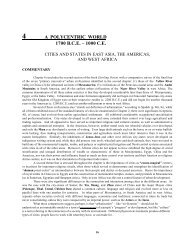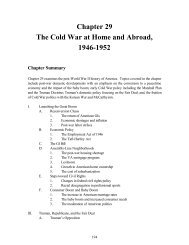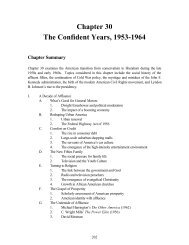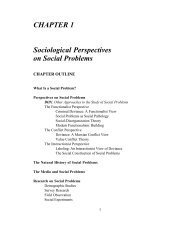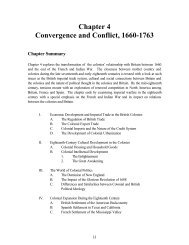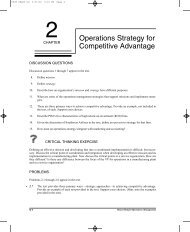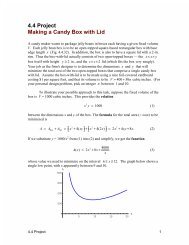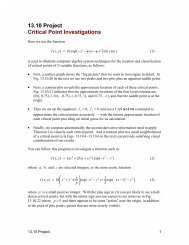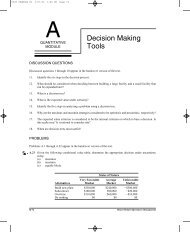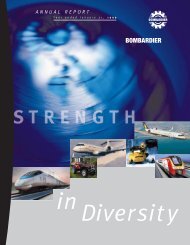Chapter 2 Transplantation, 1600-1685
Chapter 2 Transplantation, 1600-1685
Chapter 2 Transplantation, 1600-1685
You also want an ePaper? Increase the reach of your titles
YUMPU automatically turns print PDFs into web optimized ePapers that Google loves.
<strong>Chapter</strong> Summary<br />
<strong>Chapter</strong> 2<br />
<strong>Transplantation</strong>, <strong>1600</strong>-<strong>1685</strong><br />
This chapter provides a survey of the early European settlement of North America. The topics<br />
discussed include the establishment of New France; the nature of early British settlement in the<br />
Chesapeake and New England; the emergence of the plantation society in the Caribbean and<br />
the Carolinas, and the establishment of the Middle Colonies.<br />
I. The French in North America<br />
A. The Characteristics of French Colonization in North America<br />
1. French reluctance to emigrate to the New World<br />
2. Characteristics of French colonial bureaucracy<br />
B. The French Fur Trade in North America<br />
II. British Settlement of the Chesapeake<br />
A. Virginia<br />
1. The House of Burgesses and the transplantation of the<br />
British political tradition in Virginia.<br />
2. British relations with Native Americans in Virginia<br />
3. The development of the tobacco economy<br />
B. Maryland<br />
III. British Settlement of New England<br />
A. The Pilgrims and Plymouth Colony<br />
1. The Scrooby separatists<br />
2. The Mayflower Compact<br />
3. Pilgrim relations with Native Americans and the first<br />
Thanksgiving<br />
B. The Puritans and Massachusetts Bay Colony<br />
1. The covenant theology<br />
2. The General Court and the transplantation of the British<br />
political tradition in Massachusetts<br />
3. The Pequot War and Puritan relations with Native<br />
Americans<br />
4. Religious dissent in Massachusetts Bay<br />
C. The Social and Demographic Characteristics of Colonial New<br />
22
England<br />
IV. British Settlement of the Caribbean<br />
A. The Development of the Sugar Cane Economy<br />
B. The Emergence of Slavery and a Biracial Society<br />
V. British Settlement of the Proprietary Colonies<br />
A. The Carolinas<br />
1. The Fundamental Constitution of Carolina<br />
2. The rice plantation economy<br />
B. Pennsylvania<br />
1. William Penn and the Quaker religion<br />
2. The Frame of Government<br />
C. New York and New Jersey<br />
VI. Conclusion<br />
Learning Objectives<br />
After a careful examination of <strong>Chapter</strong> 2, students should be able to:<br />
1. Point out the factors which accounted for the French reluctance to emigrate to the New<br />
World.<br />
2. Explain the importance of the fur trade to the economic development of French holdings<br />
in the New World.<br />
3. Define the term joint-stock companies and identify the major ones involved in<br />
establishing the original British colonies in America.<br />
4. Define the term headright system and explain how this policy promoted British<br />
migration to the New World.<br />
5. Describe the importance of the tobacco economy to the development of the<br />
Chesapeake area.<br />
6. Describe the characteristics of the plantation society as it emerged in the Chesapeake.<br />
Define the term indentured servant and explain the role of this labor force in the plantation<br />
society.<br />
23
7. Compare and contrast the demographic characteristics of the Chesapeake and New<br />
England.<br />
8. Describe the Pilgrim settlement at Plymouth Colony and distinguish the Pilgrim theology<br />
from Puritan theology.<br />
9. Distinguish between the terms separatist and non-separatist as they relate to Calvinist<br />
theology.<br />
10. Understand the basic principles of Calvinist theology including the covenant theology<br />
and understand the importance of religion in defining Puritan culture and society.<br />
11. Describe the Massachusetts General Court and compare its structure and function to<br />
the Virginia House of Burgesses.<br />
12. Discuss the issue of dissent in Puritan society. Identify three people who dissented<br />
against the Puritan church and describe what happened to them.<br />
13. Explain the emergence in the British Caribbean of the first biracial society in the New<br />
World. Understand the nature of the Caribbean system of slavery as well as the extent to which<br />
slaves were able to preserve elements of their African culture within the system of slavery.<br />
14. Place the establishment of the Restoration colonies within the social and cultural context<br />
created by the Chesapeake and New England colonies. Explain how these colonies reflected<br />
and often blended and extended the British colonial cultures already in place by the<br />
mid-seventeenth century.<br />
Topics for Classroom Lecture<br />
1. Discuss the Chesapeake and New England colonies in a series of lectures in which you<br />
concentrate on the differences between the cultures and societies established in each of the two<br />
regions. Because the United States history course is normally split at the Civil War, you can use<br />
this opportunity to begin to discuss the fundamental differences between these two areas and<br />
introduce some distinctions between the two regions that will persist until the Civil War. Some<br />
topics for discussion might include:<br />
a. The different characteristics of the populations that originally settled these<br />
regions. From which regions in England did these original settlers come and how did the<br />
cultures and mores of these regions influence the societies that developed in North America?<br />
24
. The differences in how the original settlers of each region were motivated to<br />
come to the New World. To what extent was the state of the British economy a factor? To<br />
what extent was religion a factor? How did the differences in motivation impact the societies<br />
that emerged?<br />
c. The differences in the socio-economic characteristics of each region. Point out<br />
the distinction between the plantation society of the Chesapeake and the freeholder society of<br />
New England; explain distinctions in how land was distributed in each region and the impact<br />
that the method of land distribution had on the nature of each area’s social structure; and, point<br />
out the diversity of the New England economy versus the one-crop economy of the<br />
Chesapeake.<br />
d. The difference in the level of importance placed on religion in each region.<br />
Explain the importance of Calvinist theology in defining New England society and culture.<br />
Contrast this emphasis with the lower priority placed on religion in the South (at least until the<br />
Great Awakening). How did these religious differences impact the emergence of regional<br />
ethics?<br />
e. The differences in the political systems that emerged in the Chesapeake and<br />
New England. Why did the Chesapeake evolve into a political aristocracy while New England<br />
developed one of the most democratic political systems in America?<br />
f. In discussing fundamental differences between the North and the South prior to<br />
the Civil War, many historians have emphasized the progressive nature of the nineteenth century<br />
North and the conservative nature of the Old South. Begin now to discuss the meaning of these<br />
terms. Was there already, during the colonial period, a philosophical distinction between the<br />
settlers of New England and the Chesapeake? Was there something progressive, even radical,<br />
about the decision of the Pilgrims and Puritans to come to the New World? Were they seeking<br />
something new or trying to retain the old? Was there something conservative about the decision<br />
of the early settlers of the Chesapeake to come to the New World? Were they seeking<br />
something new or more intent on preserving the England they knew and loved?<br />
2. Prepare a lecture focusing on the life of Anne Hutchinson. A treatment of her<br />
experiences in New England can open discussion regarding a number of issues pertinent to New<br />
England culture including:<br />
a. Her theological differences with the Puritan fathers. This discussion will allow<br />
an examination of the covenant theology including the distinction between the covenant of grace<br />
and the covenant of works as well as how religious intolerance emerged within the Puritan<br />
community as a requisite aspect of the covenant principle.<br />
b. The gender issues involved with Hutchinson’s challenge to the authority of the<br />
Puritan fathers and her instruction of theology, particularly her instruction of theology to<br />
mixed-gender groups.<br />
25
3. Deliver a lecture on demographics in New England and the Chesapeake or a<br />
comparison of the two. Discuss the extent to which the study of United States history has<br />
become democratized over the past 25 years and the extent to which social history has gained<br />
in prestige and importance.<br />
Topics for Class Discussion and Essays<br />
1. Discuss the nature of colonial political development in the British colonies. How did the<br />
political institutions created in the colonies reflect British political tradition in terms of structure<br />
and function? Do today’s state and federal political structures in America resemble the<br />
institutions created by the original British colonists? How does this reflect the element of<br />
persistence over time?<br />
2. Conduct a classroom discussion which focuses on “freedom of religion.” Have students<br />
discuss the irony of the fact that we often associate freedom of religion with the Puritans who<br />
came to America to escape religious persecution. However, to what extent was freedom of<br />
religion a reality in the Puritan community? How did these dissenters treat dissenters within their<br />
own ranks?<br />
3. Compare and contrast the institutions of slavery that emerged in Virginia, South<br />
Carolina and the Caribbean. Even though each of these colonial regions was British, the<br />
institutions of slavery which developed in each were distinctive. What factors contributed to<br />
these distinctions? What impact did South Carolina’s central location between Virginia and the<br />
Caribbean have on the nature of her plantation economy and her institution of slavery?<br />
Topics for Term Papers and Class Projects<br />
1. Choose one of the three major colonial regions and write a paper in which you examine<br />
the British background of the settlers in that region. How did the cultural mores of each<br />
geographical region of Britain impact the nature and characteristics of the various British colonial<br />
settlements?<br />
2. Research one of the Puritan dissenters such as Anne Hutchinson or Roger Williams.<br />
How did their beliefs necessitate their removal from the Puritan community? How did their<br />
experiences serve to expand the meaning of religious freedom in America?<br />
26
3. Examine the origins of slavery in South Carolina. Look at the demographics of the state<br />
including the density of slave population as well as the link to the Caribbean. How did the the<br />
link to the Caribbean impact the institution of slavery that developed in South Carolina?<br />
Resources for Lectures and Research Projects<br />
David Hackett Fischer, Albion’s Seed: Four British Folkways in America (1989).<br />
Philip J. Greven, Jr., Four Generations: Population, Land, and Family in Colonial<br />
Andover, Massachusetts (1970).<br />
James A. Henretta, The Evolution of American Society, 1700-1815 (1973).<br />
Kenneth Lockridge, A New England Town: The First One Hundred Years (1985).<br />
Edmund S. Morgan, Roger Williams, the Church, and the State (1967).<br />
Peter Wood, Black Majority: Negroes in Colonial South Carolina from 1670 through<br />
the Stono Rebellion (1975).<br />
Audio-Visual Resources<br />
American Visions: The Promised Land, Time, Inc./BBC/Thirteen WNET, New York,<br />
1997, 60 minutes.<br />
This episode from the 6-part series created by Robert Hughes depicts the origins of American<br />
ideas about art. Ranging from the Spanish West to Protestant New England to the aristocratic<br />
Chesapeake, Hughes takes a look at how American art began and flourished.<br />
Jamestown Rediscovery: A World Uncovered, A&E Video.<br />
An examination of the search for the original Jamestown settlement including footage from the<br />
Association for the Preservation of Virginia Antiquities.<br />
27



